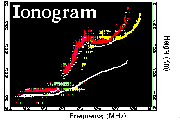Introduction to the Ionosphere
The ionosphere is that part of the upper atmosphere where free electrons occur in sufficient density to have an appreciable influence on the propagation of radio frequency electromagnetic waves. This ionization depends primarily on the Sun and its activity. ionospheric structures and peak densities in the ionosphere vary greatly with time (sunspot cycle, seasonally, and diurnally), with geographical location (polar, auroral zones, mid-latitudes, and equatorial regions), and with certain solar-related ionospheric disturbances. The major part of the ionization is produced by solar X-ray and ultraviolet radiation and by corpuscular radiation from the Sun. The most noticeable effect is seen as the Earth rotates with respect to the Sun; ionization increases in the sunlit atmosphere and decreases on the shadowed side. Although the Sun is the largest contributor toward the ionization, cosmic rays make a small contribution. Any atmospheric disturbance affects the distribution of the ionization. The ionosphere is a dynamic system controlled by many parameters including acoustic motions of the atmosphere, electromagnetic emissions, and variations in the geomagnetic field. Because of its extreme sensitivity to atmospheric changes, the ionosphere is a very sensitive monitor of atmospheric events. In some circles it is thought that there is persuasive evidence of an ionospheric precursor to large earthquakes that can be used a predictor. Besides the obvious acoustic waves generated before and during an earthquake, a part of the preparation process of large earthquakes is the generation of electromagnetic emissions (EMEs). These EMEs have been detected in the ionosphere up to six days prior to a large earthquake, such as with the May 1960, Chilean 8.3 earthquake. The most accurate way of measuring the ionosphere is with a ground-based ionosonde, which records data as ionograms. |
